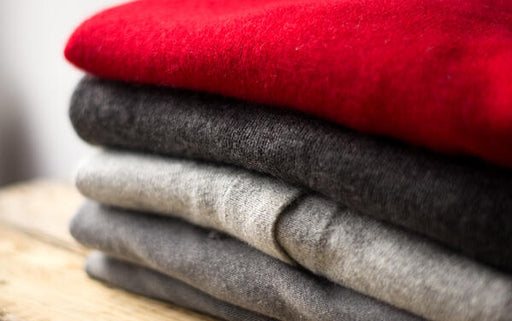Can You Wash A Cashmere Sweater?

Maintaining your cashmere sweater’s pristine condition keeps these luxurious garments wearable and worthwhile investments for years to come. Once you know how to clean your cashmere at home with the appropriate techniques and a few wool-friendly products, you’ll be able to wear them with confidence and store them safely for any season.
Is it Safe to Wash a Cashmere Sweater at Home
It’s easy to assume that when an expensive or valuable piece of clothing needs to be cleaned that dry cleaning is the best way to go. With natural textiles like cashmere, this isn’t always the case. The harsh solvents used in dry cleaning can actually strip the downy, fragile fibres that give a cashmere sweater its light, soft texture. The label on your garment is the best place to look for care instructions like these, so always check to see if it specifies dry cleaning only.
Even if the label indicates the garment should be dry cleaned, you can still care for cashmere clothing and garments by washing the article of clothing by hand, instead. Many fashion-conscious cashmere owners prefer hand washing over dry cleaning simply because they like to have control over the entire cleansing process from start to finish. This is especially true for heirloom or antique pieces of cashmere clothing, such as pashmina shawls or vintage cardigans that may have been passed down from beloved family members through the generations.
Because cashmere is made from the short fibres of a goat’s winter undercoat, it’s vulnerable to pilling. This causes small balls of fabric to form on the surface of the clothing that need to be removed with a comb specifically made to smooth woolly garments. Frequent washing contributes to excessive pilling, so it’s recommended that you wear a cashmere garment a few times between washes. However, if you’re dealing with a stain or storing it away for the season, it should be treated and washed right away or just prior to storing it.

How to Wash Cashmere Sweaters at Home
In order to avoid pulling or stretching a wet cashmere garment too much, clean each piece you have separately and use fresh water with each wash.
Pre-treating stains on cashmere can be tricky, so be sure to use stain removers that are labelled wool-safe. Avoid scrubbing cashmere as this can damage its short fibres permanently.
Step 1: Clean sink or tub prior to washing Cashmere
The tiniest bit of grime or grit could do significant damage to a fabric as vulnerable as cashmere is when it’s wet, so make sure you’re starting with a clean slate. Make sure the sink, basin or tub you plan to use is big enough for your garment to fit in while fully submerged.
Step 2: Lukewarm or cool water works best on Cashmere
When wet, natural fibres like cashmere already lose some of their elasticity — that is, their ability to return to their former shape once stretched — hot water weakens these fibres even further. The temperature of the water should be no hotter than 40 degrees Celsius (around 104 degrees Fahrenheit), but cooler water is often preferred for the safest washing experience.
Step 3: Use a mild detergent that's Cashmere-safe
While it may be safe to use baby shampoo or a mild dish washing liquid in a pinch, especially if you’re grappling with a sudden stain that needs a quick treatment, you should invest in a wool-safe and cashmere-friendly detergent for long-term use.
These specialized detergents help maintain and condition the natural fibres of textiles like cashmere, which are more likely to break down when stripped by harsher detergents. As an added precaution, avoid using harsh chemical cleaners, especially anything with bleach in it.
Step 4: Fully submerge Cashmere garment
If you’re using a big enough space and the right volume of water, you should be able to submerge your cashmere entirely. Because you cannot scrub or stretch the garment, you must depend on the free-flowing movement of soap-infused water through the fibres of your cashmere to clean it. You can aid this process by gently agitating the water, but always avoid pulling at the fabric itself.
Step 5: Soak for at least five minutes
Once you’ve made sure the entire garment has been saturated, you can leave it to soak. This will help the surface of the cashmere to release any oily residues or particles of dirt. If you know your garment is only in need of a basic wash, then a five-minute soak should suffice. When you’re faced with tougher cashmere stains or odours, you should allow it to soak for longer — but not more than 30 minutes.
Step 6: Use white vinegar to kill odors
During the rinsing process, you can add an extra step if you want to be sure you’ve rid your garment of any lingering odours. Refill the tub or sink with enough water to cover the piece of cashmere clothing and add up to 3/4 cup of white distilled vinegar. It doesn’t need to soak for long, but you should make sure to rinse through the garment thoroughly to release all the soap and any vinegar that remains.
Step 7: Squeeze to release excess water
Fully saturated cashmere is at its most vulnerable to permanent damage, so you should treat wet clothing with incredible care. Squeeze it section by section until you’ve released as much water as possible before lifting it out of the tub or sink. Never twist or wring natural textiles like cashmere as this can cause the fibers to break and the shape to stretch disproportionately and permanently.

Safe Methods for Drying Cashmere Sweaters
Allowing cashmere garments to dry naturally takes a little patience and a safe place to let them sit for long enough to dry. The thicker the weave, the longer it may take. Heat and light both pose a risk of damage, so you should avoid setting them near any hot surfaces or windows that let in bright light.
Some clothing made with cashmere can include synthetic blends that can withstand tumble-drying, but this is still a risky undertaking. Once wools like cashmere shrink, they can never be restored to their former glory, even if you try methods that unshrink cashmere. Even a no-heat setting on a dryer can still stretch or cause the fabric to lose its shape.
If you need to speed up the drying process for your piece of cashmere clothing, try sandwiching it between two towels. You can gently press it between the towels or roll it up and allow the light pressure between the layers to wick away the wet. Steaming can help release wrinkles on a dry garment. If the care instructions indicate low-heat ironing is suitable, use a pressing cloth and turn your garment inside out to minimize the chance of causing damage.
Storing and Protecting Your Cashmere Sweater
The seasonal nature of many pieces of cashmere clothing means they wind up in storage at some point in the year, which can pose its own set of problems. Because it can easily lose its shape, a cashmere sweater should never be put on a hanger for long periods of time. You should fold cashmere clothing carefully and use acid-free tissue paper between its layers to help prevent friction damage and allow it to breathe.
Cotton or breathable zippered bags can be your best friend when it comes to preventing moth infestations, which thrive in the dark where moth larvae like to feast on any proteins they find within the cashmere fibres. Not only should you toss in a few cedar balls or anti-moth lavender sachets, but you should be sure to air out your stored cashmere from time to time to make sure clothes moths haven’t had a chance to make themselves at home in the folds of your precious pieces.
Check out more posts on our blog, such as tips for cashmere care and clothes moth larvae prevention.
About MothPrevention
MothPrevention® speak to customers every day about their clothes moth issues - clothes moths are a species that are ever increasing and that can cause significant damage to clothes, carpets and other home textiles.
To date, we’ve helped over 250,000 customers deal with their moth problems. We have developed professional grade solutions including proprietary pheromones and trap design engineered to the highest production standards.





